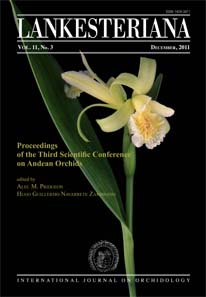Fitness landscapes in orchids: parametric and non-parametric approaches
DOI:
https://doi.org/10.15517/lank.v11i3.18291Keywords:
orchid flowers, natural selection, fitness advantage, mathematical modelsAbstract
Natural selection and genetic drift are the two processes that can lead to cladogenesis. Without a doubt the great diversity and floral adaptation to specific pollinators are likely consequences of natural selection. Detecting natural selection in the wild requires measuring fitness advantage for specific characters. However, few published orchid studies demonstrate that floral characters are influenced by natural selection. If selection is temporal or weak, then this may explain why we rarely find selection on floral characters. Alternatively, selection on a character may not follow commonly used mathematical models that are based on linear, disruptive, and stabilizing selection and serve as null models. Moreover, fitness advantages are usually tested on general models, which assume that the parameters are normally distributed. If we forego the idea that selection follows specific mathematical models and Gaussian distribution and that all types of selection landscapes and other types of distributions (binomial, Poisson) are possible, we may discover evidence that the process of selection does play a role in explaining the great diversity of orchids. Here I show and compare the use of traditional and non-parametric approaches for measuring selection of floral characters. I hypothesize that many characters are likely to be influenced by selection but, using traditional approaches, will fail to observe selection on the measured characters, whereas non-parametric approaches may be more useful as a tool to detect selection differences among characters.
Downloads
Downloads
Published
How to Cite
Issue
Section
License
According to the Open Access policy promoted by the University of Costa Rica, all the papers published by Lankesteriana are licensed under the Creative Commons copyright and can be downloaded free of charge. The journal holds copyright and publishing rights under the CC BY-NC-ND 3.0 CR license.
Before the publication of the materials submitted by the author(s) in LANKESTERIANA, the author(s) hereby assign all rights in the article to the Lankester Botanical Garden.





